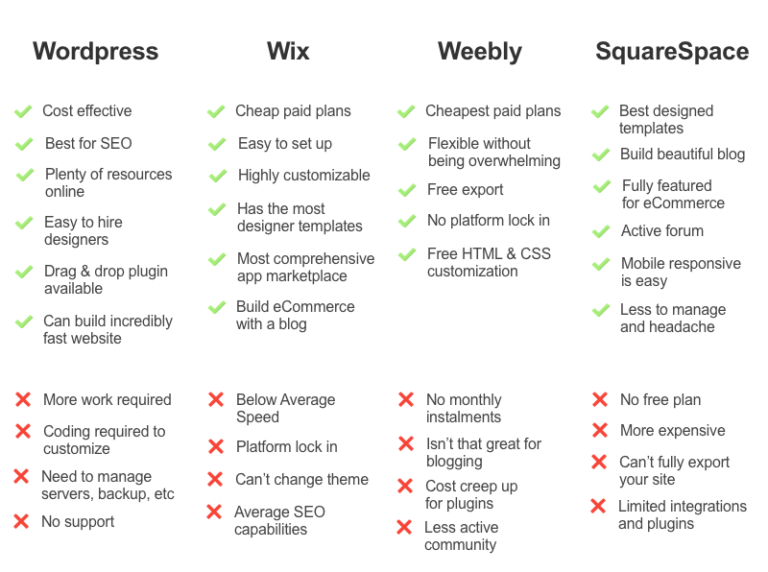Squarespace Vs WordPress
Squarespace and WordPress are two popular website builders. Each offers unique features and capabilities.
Choosing the right platform can be challenging. Both Squarespace and WordPress cater to different needs. Squarespace is known for its sleek, user-friendly design. WordPress offers extensive customization and flexibility. Understanding the differences between these platforms is crucial. It helps you make an informed decision.
This comparison will provide clarity. You will learn which platform suits your needs best. Whether you prioritize design or customization, this guide will help. Dive in to explore Squarespace vs. WordPress. Make the right choice for your website.
Ease Of Use
Choosing the right platform for your website can be challenging. For many, ease of use is a key factor. Both Squarespace and WordPress have their strengths. Let’s compare them based on ease of use.
User Interface
Squarespace offers a sleek, user-friendly interface. Its drag-and-drop builder is intuitive. You can easily add and arrange elements. The design is visually appealing and straightforward.
WordPress, on the other hand, has a more traditional interface. It provides a dashboard with various menus. The interface can be overwhelming for beginners. Plugins can enhance functionality, but finding the right ones can be tricky.
Learning Curve
The learning curve for Squarespace is gentle. Users can start building immediately. The platform offers built-in tutorials and guides. Most users can create a basic site in a few hours.
WordPress has a steeper learning curve. It requires some technical knowledge. Users need to understand themes, plugins, and widgets. It may take days or weeks to master. WordPress also has a vast community and resources.
| Feature | Squarespace | WordPress |
|---|---|---|
| User Interface | Intuitive, drag-and-drop | Traditional, menu-based |
| Learning Curve | Gentle, easy to follow | Steep, requires technical knowledge |
In summary, Squarespace is easier for beginners. WordPress offers more flexibility but has a steeper learning curve. Choose based on your comfort level and needs.

Credit: kinsta.com
Design And Customization
Design and customization are crucial for creating a unique website. Squarespace and WordPress offer various options. Both platforms cater to different needs. Let’s explore their strengths and differences.
Template Options
Squarespace provides a range of high-quality templates. These templates are professionally designed and visually appealing. They cater to different industries like blogs, portfolios, and online stores.
WordPress, on the other hand, offers thousands of themes. Some are free, while others are premium. Themes vary in style and functionality. This variety allows more personalization.
| Squarespace | WordPress |
|---|---|
| Limited but polished templates | Thousands of themes |
| Industry-specific designs | Many free and premium options |
Customization Flexibility
Squarespace offers a user-friendly editor. You can drag and drop elements. This makes it easy for beginners. Customization options are more limited compared to WordPress.
WordPress excels in flexibility. It allows extensive customization. Users can edit code and add plugins. This platform is ideal for those needing advanced features.
- Squarespace: Intuitive drag-and-drop editor
- WordPress: Extensive plugin library for customization
- Squarespace: Limited to built-in features
- WordPress: Ability to edit HTML, CSS, and PHP
Performance And Speed
Performance and speed are crucial for any website. A fast site enhances user experience and improves SEO. Let’s compare Squarespace and WordPress in terms of loading times and optimization features.
Loading Times
Squarespace offers built-in performance tools. These tools help maintain quick loading times. Since it’s a closed platform, Squarespace controls the environment. This results in consistent performance for most users.
WordPress, on the other hand, depends on your hosting provider. With the right hosting and setup, WordPress can be very fast. But, it requires careful management. Poorly optimized themes or plugins can slow down your site.
Optimization Features
Squarespace includes several optimization features out of the box. These include image optimization and a content delivery network (CDN). These features ensure your site runs smoothly.
WordPress offers more flexibility with optimization. You can choose from various plugins for caching, image optimization, and CDN services. This allows for tailored optimization based on your needs. But it also requires more know-how to set up correctly.
Seo Capabilities
When comparing Squarespace and WordPress, SEO capabilities play a crucial role. Both platforms offer various tools to help improve your website’s visibility. Let’s dive deeper into the features they offer under the subheadings Built-in Tools and Advanced SEO Options.
Built-in Tools
Squarespace has built-in SEO tools that are easy to use. These tools include automatic sitemaps, clean URLs, and SSL certificates. Squarespace also provides customizable meta tags and descriptions. This makes it simple for beginners to optimize their sites.
WordPress, on the other hand, requires plugins for most SEO tasks. Yoast SEO is a popular choice. This plugin offers features like keyword optimization, content analysis, and readability checks. With WordPress, you have greater control over your SEO settings.
Advanced Seo Options
Squarespace offers fewer advanced SEO options. It focuses on simplicity and ease of use. This is great for users who want a straightforward approach. However, for advanced SEO tactics, you may find it limiting.
WordPress excels in advanced SEO options. Plugins like Yoast SEO and All in One SEO Pack provide in-depth features. These include XML sitemaps, breadcrumb navigation, and social media integration. WordPress allows for more customization and advanced settings.
E-commerce Features
Both Squarespace and WordPress offer robust e-commerce features. But they differ in setup, payment options, and other aspects. Let’s delve into these key areas to help you choose the best platform for your online store.
Store Setup
Squarespace offers a user-friendly store setup. Its drag-and-drop interface makes it easy to design your store. You can choose from various templates tailored for e-commerce. Each template is mobile-responsive and visually appealing.
WordPress requires more effort to set up an online store. You need to install the WooCommerce plugin for e-commerce features. WooCommerce is powerful and flexible but has a steeper learning curve. You may also need additional plugins to enhance functionality.
| Feature | Squarespace | WordPress (with WooCommerce) |
|---|---|---|
| Ease of Setup | High | Moderate |
| Templates | Included | Requires Theme |
| Mobile Responsiveness | Yes | Depends on Theme |
Payment Integration
Squarespace supports various payment gateways. You can integrate with Stripe, PayPal, and Apple Pay. It also offers seamless checkout experiences for users. No additional plugins are needed for payment processing.
WordPress with WooCommerce supports many payment gateways. You can use Stripe, PayPal, Square, and more. Integration may require additional plugins, which can be both free and paid. This provides flexibility but adds complexity.
- Squarespace: Built-in payment options.
- WordPress: Requires plugins for payment integration.
For a simple setup, Squarespace is ideal. For flexibility, WordPress is better. Choose based on your technical skills and business needs.

Credit: kinsta.com
Support And Community
Choosing between Squarespace and WordPress often boils down to the support and community available. Both platforms have strengths, but they cater to different needs. Understanding their support systems and community resources can help you make an informed choice.
Customer Service
Squarespace offers 24/7 customer support via email and live chat. Their support team is known for quick responses and detailed solutions. Squarespace also provides a comprehensive knowledge base with articles and tutorials.
WordPress customer service varies. If you use WordPress.com, you get email and live chat support based on your plan. WordPress.org users rely on community forums, though some hosting providers offer support.
Community Resources
Squarespace has a smaller community compared to WordPress, but it is active and supportive. You can find resources in the form of:
- Official forums
- Facebook groups
- Third-party blogs and tutorials
WordPress boasts one of the largest online communities. The resources available are vast:
- Official WordPress forums
- Meetups and WordCamps
- Countless blogs, YouTube channels, and courses
| Criteria | Squarespace | WordPress |
|---|---|---|
| Customer Support | 24/7 via email and chat | Varies, often community-based |
| Community Size | Smaller but active | Large and extensive |
| Resources | Knowledge base, forums, groups | Forums, meetups, extensive online content |
In summary, Squarespace provides more direct customer support, while WordPress offers a vast community with extensive resources. Choose based on your preference for immediate help or community-driven support.
Pricing
Pricing plays a crucial role in deciding between Squarespace and WordPress. Both platforms offer different pricing models and plans. Understanding these can help you choose the right one for your needs and budget.
Subscription Plans
Squarespace offers a range of subscription plans to suit various needs. Here’s a breakdown:
- Personal Plan: $12/month (billed annually)
- Business Plan: $18/month (billed annually)
- Basic Commerce Plan: $26/month (billed annually)
- Advanced Commerce Plan: $40/month (billed annually)
These plans include website hosting, templates, and support. Everything you need to get started.
WordPress, on the other hand, has different pricing options:
- Free Plan: $0 (limited features)
- Personal Plan: $4/month (billed annually)
- Premium Plan: $8/month (billed annually)
- Business Plan: $25/month (billed annually)
- Ecommerce Plan: $45/month (billed annually)
WordPress pricing covers hosting, themes, and support. It also offers a free plan with limited features.
Value For Money
Squarespace provides all-in-one solutions. You get hosting, templates, and support in one package. This makes it simpler for users who need a straightforward solution. The plans cater to different business needs, from personal blogs to online stores.
WordPress offers more flexibility and customization. The free plan is a good starting point for beginners. Paid plans provide more features, including premium themes and plugins. This flexibility allows you to tailor your website as you grow.
Here’s a quick comparison table:
| Platform | Plan | Cost (monthly, billed annually) | Included Features |
|---|---|---|---|
| Squarespace | Personal | $12 | Hosting, Templates, Support |
| Squarespace | Business | $18 | Hosting, Templates, Support, E-commerce |
| WordPress | Free | $0 | Basic features, Limited storage |
| WordPress | Personal | $4 | Hosting, Support, Custom Domain |
| WordPress | Premium | $8 | Hosting, Premium Themes, Monetization |
Choosing between Squarespace and WordPress depends on your specific needs. Squarespace offers simplicity, while WordPress provides more flexibility and customization.

Credit: www.nerdwallet.com
Frequently Asked Questions
What Are The Key Differences Between Squarespace And WordPress?
Squarespace offers an all-in-one solution with hosting, templates, and support. WordPress is more flexible, requiring separate hosting and more customization. Squarespace is user-friendly for beginners. WordPress is ideal for those wanting extensive control and customization.
Which Platform Is Easier For Beginners?
Squarespace is generally easier for beginners. It provides an intuitive drag-and-drop interface and pre-designed templates. WordPress has a steeper learning curve but offers more customization options.
Can I Migrate From Squarespace To WordPress?
Yes, you can migrate from Squarespace to WordPress. The process involves exporting content from Squarespace and importing it into WordPress. Some manual adjustments may be needed for a seamless transition.
Which Platform Is Better For E-commerce?
WordPress, with WooCommerce, offers extensive e-commerce features and scalability. Squarespace has built-in e-commerce tools that are simpler but less flexible. Choose based on your business needs.
Conclusion
Both Squarespace and WordPress offer unique benefits. Squarespace is user-friendly and great for beginners. WordPress provides more customization and flexibility. Your choice depends on your needs. If ease and design matter, pick Squarespace. For more control and features, choose WordPress.
Both platforms can help you build a beautiful website. Evaluate your priorities and go with the best fit. Happy website building!





